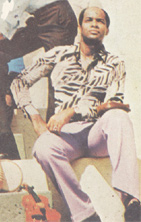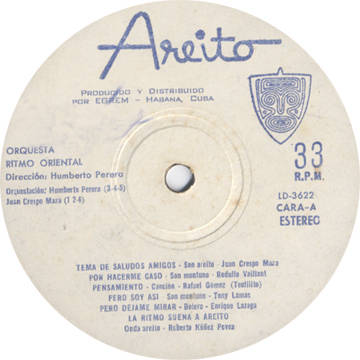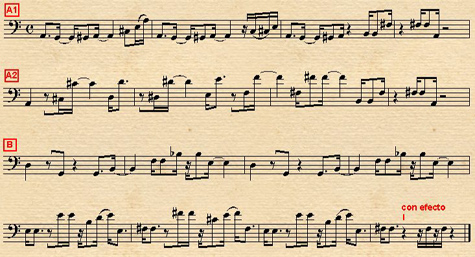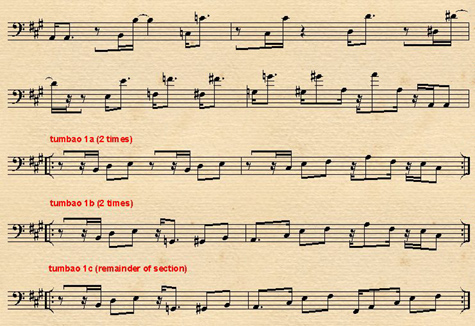Indice - Table of contents
New Stuff[hide]
Reportes: From The St... : Cubadisco 2...
Fotos: Tom Ehrlich
Staff: Kristina Lim
Musicos: Juan Formell
Musicos: Yordamis Megret Planes
Musicos: Yasser Morejón Pino
Musicos: José Luis "Changuito" Quintana...
Musicos: Dennis Nicles Cobas
Fotos: Eli Silva
Grupos: Ritmo Oriental : 1988 - Vol. IX - 30 a...
Musicos: Rafael Paseiro Monzón
Musicos: Jiovanni Cofiño Sánchez
Fotos: Tom Ehrlich : 2024 Monterey Jazz, P...
Resenas: Vacilón Santiaguero (Circle 9 ...
Photos of the Day [hide]
The Roots of Timba - Part II - Juan Crespo Maza

(look for a timba.com interview with JC Maza soon)
Juan Crespo Maza is la Ritmo's most prolific composer and arranger, and was also their most prominent lead vocalist until a throat operation sidelined him in around 1980. Among his compositions are Mi socio Manolo, La chica mamey, Nena, así no se vale, Ahora sí voy a gozar, Se perdió el amor, Que se sepa bien, mi amor, Quién dice, Enséname tu baile Lola, Tema de saludos, and Yo traigo panetela.
Maza also contributed brilliant arrangements to many of the songs that he himself didn't write, such as Por hacerme caso, Un matrimonio feliz, and the masterpiece we're about hear - La Ritmo suena a Areíto. This one, mercifully, is one of only three from this album to make it onto a compilation CD.

1977 Ritmo Oriental - La Ritmo suena a Areíto (Roberto Núñez)
bass: Humberto Perera - arranger: JC Maza
source: Ritmo Oriental is Calling You
If the reader is willing to humor me, I'd like to try a very simple experiment:
Before looking at any of the notation examples below, listen the opening of the track several times and answer two questions:
1) Does the rhythmic placement of the phrase "con la nueva onda Areíto" throw you off?
2) How much do you like this song?
In my case, the answers were "yes" and "it's my favorite Ritmo Oriental track so far", and I suspect that these two answers are related. My theory is that when a passage can be heard several ways, it becomes more interesting with repeated listenings. For example, here's a list of Charanga Habanera songs which I initially found very difficult to learn to hear correctly, but which rank among my favorite Cuban arrangements:
Extraños ateos
Nube pasajera
Usa condón
Hagamos un chen
Un disparo en la mirada
(Analyses of each of these can be found in our Charanga Habanera section.)
The opening rap of La Ritmo suena Areíto leaves no doubt whatsoever where "1" is, but when I first heard the melodic coro that answers that rap, it seemed to come in a beat early. As you can see from the notation below, however, it all fits nicely in 4/4. In order to hear it correctly, you have to hear "onda" as the downbeat instead of hearing (as I did) "la" as the pickup. To train myself to hear it, I used the "TwistaLoop" function of Emulator X to make this training file which establish onda as the downbeat and then gradually adds the rest of the phrase in looped form.
correct:
xxxx xxxx x0x0 x000 con - la - nu - e - va
0x00 0xx0 xxxx xxxx on - da'a - re - í - to
the way my ear wanted to hear it:
xxxx xxxx xxxx x0x0 con - la
x000 0x00 0xx0 xxxx nu - e - va - on - da'a - re - í - to
Now, why is this phrase so likely to throw listeners off? I've found that in almost every case, it's the harmony, not the syncopation, that plays tricks on our ears. The song starts out with a typical funk groove in the key of A, but modulates to Bmi on beat 4. The chords that follow it seem to reinforce the false impression that Bmi is the beginning of a new measure:

Now that we know where "1" is, we can fully appreciate JC Maza's arrangement and Humberto Perera's glorious bass part.
La Ritmo suena a Areíto cuerpo -- audio -- MIDI

The opening phrase we've been discussing (A1) is repeated (A2), but this time the bass, playing in funk-influenced octaves, moves up the chromatic scale every beat and a half, culminating in the same brief modulation from A to B minor. The B section's bassline -- also very strange and funky in both its rhythm and harmony -- modulates between D and Bmi.
The whole cuerpo repeats, with a few nice variations in the bass, and then the upward chromatic bassline returns for a third time, but as the rap becomes more urgent, the bass starts ascending more quickly, changing notes every beat instead of every beat and a half, until the passage explodes climactically into F# minor for the first coro:
La Ritmo suena a Areíto transition & tumbao 1 -- audio -- MIDI

Tumbao 1a is in F#mi (E - F#mi) but repeats only twice before settling into A major (E - A) for tumbaos 1b and 1c.
Now let's look at the 3 tumbaos relative to the clave:
xx0x 0xxx 0xx0 xxx0 2-3 rumba clave
xxx0 0x0x xxx0 0x0x
xxx0 0x0x x0x0 x00x tumbao 1a
xxx0 0x0x x0xx 0x0x
0xx0 0x0x x0x0 x00x tumbao 1b
xxx0 0x0x x0xx 0x0x
0xx0 0x0x 00x0 x00x tumbao 1c
Just as Humberto's chromatic octave run provided an explosive launching pad for tumbao 1, the second main tumbao is introduced by a furious set of bloques:
La Ritmo suena a Areíto bloques -- audio -- MIDI
xxx0 0x0x x0xx 0x0x (tumbao 1c)
0xx0 0x0x 00x0 0xxx (con efecto starts with underlined note)
00x0 xx00 x0xx 00x0 bloques
x000 00x0 x000 x00x
Or, if you prefer notation:

For tumbao 2 Humberto creates the effect of a pedal tone (E) while still managing to outline the chord progression (E - F#mi). The MIDI example is just the basic part - in practice, he varies it almost every time.
xx0x 0xxx 0xx0 xxx0 2-3 rumba clave
0xx0 xx0x xxx0 xx0x
0xx0 xx0x xxx0 xx0x tumbao 2 - MIDI
The brilliant idea of two different coro sections answering each other was later adopted by Charanga Habanera in many arrangements and perhaps most famously by Paulito FG in De la Habana.
La Ritmo suena a Areíto is a masterful arrangement. Every section and every idea is bubbling over with inspiration - from the opening notes to the fade out a capella ending.

















